#fossil sea urchin shell
Explore tagged Tumblr posts
Photo

Circopeltis baicheri Regular Echinoid Fossil, Ypresian Stage, Eocene France | Authentic Specimen + COA
CIRCOpeltis baicheri Regular Echinoid Fossil – Ypresian Stage, Early Eocene, Antugnac, France
This well-preserved fossil specimen is a rare Circopeltis baicheri, a regular echinoid (sea urchin) that lived during the Ypresian stage of the Early Eocene, approximately 56 to 47.8 million years ago. Found in the renowned marine fossil beds of Antugnac, southern France, this specimen exemplifies the morphological diversity and beauty of post-Paleocene echinoids.
Fossil Type & Species:
Type: Invertebrate Fossil (Regular Echinoid/Sea Urchin)
Species: Circopeltis baicheri
Phylum: Echinodermata
Class: Echinoidea
Order: Cidaroida (tentative placement)
Family: Cidaridae or related regular echinoid lineage
Described by: (Exact authority not formally cited; likely post-WWII paleontological records in European literature)
Geological & Stratigraphic Details:
Location: Antugnac, Aude, Occitanie, France
Formation: Ypresian marine marl and limestone beds
Geological Stage: Ypresian (Early Eocene)
Age: ~56–47.8 million years ago
Depositional Environment: Warm, shallow marine environment with carbonate-rich mud and fine sediment ideal for the preservation of echinoids
Biozone: Not specifically assigned; part of the broader Eocene echinoid-bearing beds of southern France
Morphology & Features: This Circopeltis baicheri specimen is noted for:
Symmetrical, globular to slightly flattened test (sea urchin shell)
Five distinct ambulacral zones with regularly spaced tubercles
No visible spines attached, though tubercle positions are preserved
Test diameter and surface ornamentation consistent with regular echinoid structure
Preserved in light beige to grey tones, sometimes with original sediment matrix attached
Notable: Circopeltis is a lesser-known but scientifically relevant genus of regular echinoids from the Eocene of France. Specimens like baicheri are rarely seen outside academic collections. Their presence helps define biodiversity recovery and reef evolution in the early Paleogene after the K-Pg mass extinction.
Specimen Details:
Origin: Antugnac, France
Species: Circopeltis baicheri
Fossil Type: Echinoid Shell (Regular Sea Urchin)
Geological Stage: Ypresian, Early Eocene
Size Reference: Scale rule square = 1cm (see photo for exact size)
Note: You will receive the exact specimen shown in the photograph
Authenticity & Quality: This fossil is professionally verified and 100% genuine. It comes with a Certificate of Authenticity. No restoration, casting, or enhancement has been applied.
Why Choose This Fossil? Ideal for:
Fossil collectors and echinoderm enthusiasts
Educational and teaching displays
Early Paleogene marine life studies
Decorative fossil art with scientific value
Shipping & Packaging: Fast, tracked shipping with secure, eco-conscious packaging. Each fossil is handled with expert care to ensure safe delivery.
Add a scientifically significant and visually elegant Circopeltis baicheri echinoid fossil to your collection from the beautiful marine beds of Antugnac, France.
All of our Fossils are 100% Genuine Specimens & come with a Certificate of Authenticity.
#Circopeltis baicheri echinoid fossil#Eocene sea urchin France#Ypresian echinoid fossil#Antugnac fossil echinoid#regular echinoid fossil#real fossil sea urchin#authentic echinoderm fossil#fossil with COA#French echinoid fossil#collector sea urchin fossil#regular echinoidea fossil#rare Eocene fossil#echinoderm fossil specimen#fossil sea urchin shell
0 notes
Text
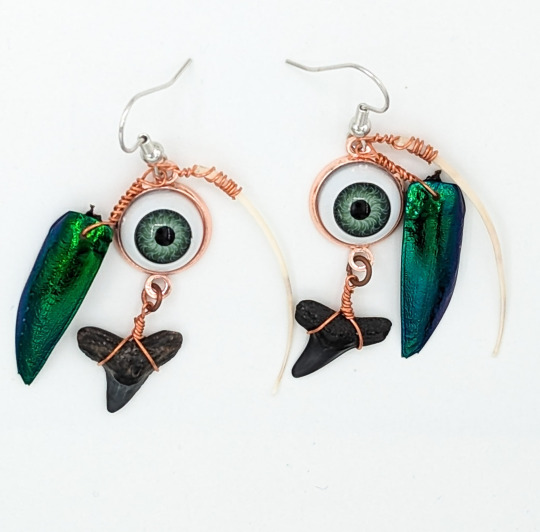
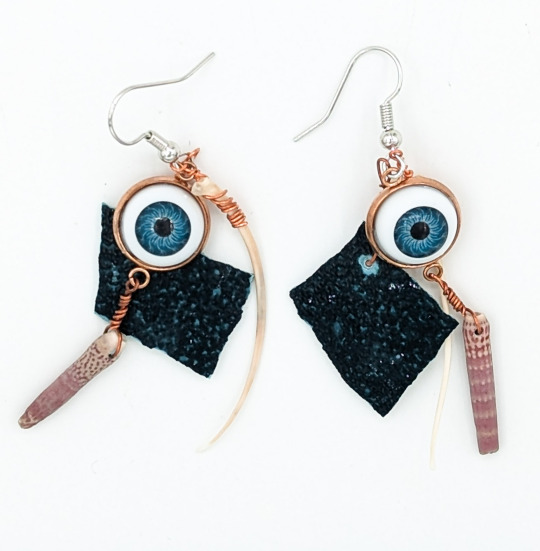


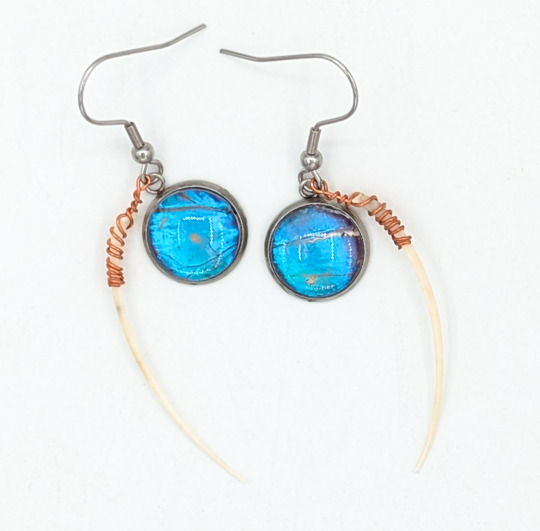

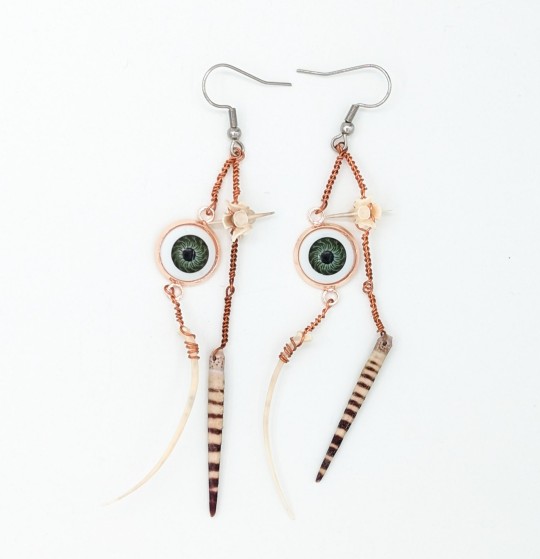
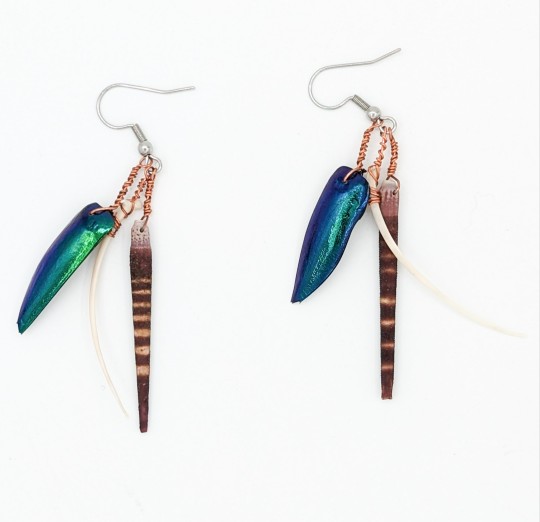

Curio collection earrings! Just listed a backlog of earrings (link in bio if you want one!) Featuring doll eyes, snake bones, beetle shells, sea urchin spines, and more!
#oddities#vulture culture#goblincore#cabinet of curiosities#dangle earrings#curio collection#natural history#curio#doll eyes#eyeballs#scopophobia#it watches#eye#beetle shell#cicada wing#snake bones#fossils#sea urchin spines#blue morpho#butterfly wings#nature jewelry
41 notes
·
View notes
Text

4 notes
·
View notes
Text


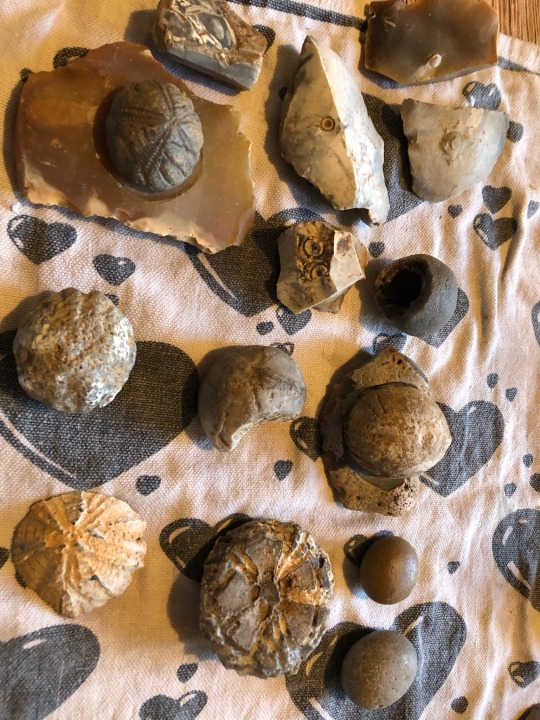

More photos are coming.
Have an free Sunday with Fossils & Coffee after.
Found probably three flints with mussels, two shards from urchin molds.
And then the fragmented & intact urchins. Three have bad effect from the naturell erosion progress, but it‘s the work of time, so it‘s fine.
The one little in gray urchin fossil is intact.
Also found the matching pieces of an brocken intact echinodea family speciemen.
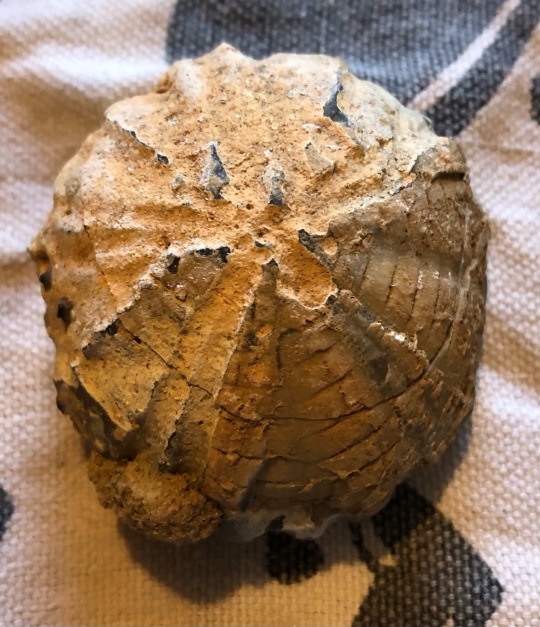
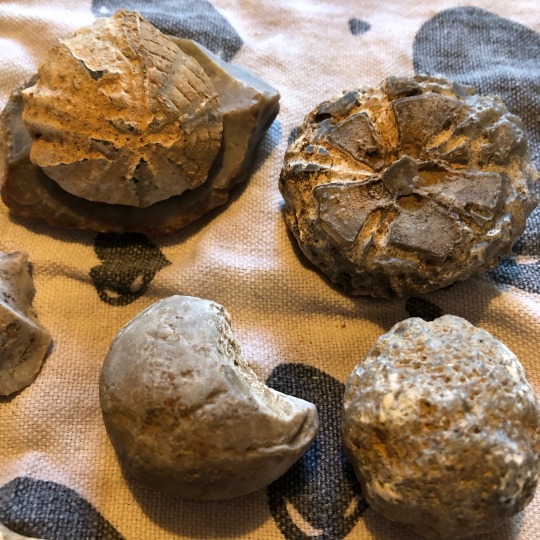
#fossils#rocks#geology#fossil hunt#fossil collection#fossil collecting#fossils in germany#fossils 2024#sea shells#sea urchin
18 notes
·
View notes
Text
Round 3 - Chondrichthyes - Heterodontiformes




(Sources - 1, 2, 3, 4)
While several extinct genera of Heterodontiformes are known from the Jurassic, today only one genus, Heterodontus, the “Bullhead Sharks” remains. Ten living species of bullhead shark have been described.
Bullhead sharks are relatively small, with the largest species reaching just 1.65 metres (5.5 ft) in maximum length. They have tapered bodies, with blunt, proportionally large heads, relatively small mouths, pig-like snouts, and pronounced ridges above their eyes. They have two large dorsal fins, the first larger than the second, and an anal fin. Both dorsal fins have a rigid spine at the front of each fin which is used for defense. Bullhead Sharks are bottom feeders in tropical and subtropical waters. They have cusped grasping teeth at the front of the mouth, and flattened teeth at the back of the mouth. They use the flattened teeth at the back of their mouth to crush hard-shelled prey like bivalves, crustaceans, and sea urchins, and the grasping teeth on soft-bodied prey like worms, anemones, and octopuses. They hunt at night by "walking" along the sea floor with alternating motions of their pectoral and pelvic fins.
Bullhead shark egg cases are shaped like an auger, with two spiral flanges. This allows the egg cases to become wedged in the crevices of rocky sea floors, where the eggs are protected from predators; however, some bullhead sharks deposit their eggs on sponges or seaweed. Due to their spiral shape, each egg case requires several hours to rotate out of the mother shark's cloaca (Oof). She usually lays two at a time. The eggs typically hatch after 7 to 12 months, depending on the species. The pups will usually reach over 14 cm in length by the time they leave the egg case.
The Heterodontiforms appear in the fossil record in the Early Jurassic, with modern forms appearing in the Late Jurassic. Despite the very ancient origins of the genus, phylogenetic evidence indicates that all living species in the genus arose from a single common ancestor that survived the K-Pg extinction.

Propaganda under the cut:
Female Japanese Bullhead Sharks (Heterodontus japonicus) are known to deposit their eggs in communal nests, with as many as 15 eggs left in the same nest.
Horn Sharks (Heterodontus francisci) (image 2) have relatively small territories they hunt in at night, returning to the same “house” during the day. They may remain faithful to the same territory for over a decade. Now that’s a homebody.
Horn Sharks are queued by light rather than by an internal clock. In laboratory settings, they will become active as soon as lights are turned off. If they are in the middle of something when the lights are turned on, they may stop swimming and sink to the bottom. In one experiment where the sharks were kept in darkness, they remained continuously active for 11 days before slowing from fatigue. (☹️)
The Horn Shark generates the highest known bite force relative to its size of any shark, which it uses to crack into mollusks, echinoderms, and crustaceans. One study found the average bite force for this species in the wild to be 95 N with a maximum of 135 N, while under experimental conditions sharks could be induced to bite with over 200 N of force.
Female Horn Sharks in the wild pick up their egg cases in their mouths and wedge them into crevices to keep them safe.
In July 2018, three people were arrested after stealing a juvenile Horn Shark from the San Antonio Aquarium. The shark was scooped out of its tank and smuggled out of the aquarium in a stroller, wrapped in a wet blanket. It was thankfully returned unharmed two days later.
The Crested Bullhead Shark (Heterodontus galeatus) (image 4) produces spiral-shaped egg capsules that are secured to seaweed or sponges with long tendrils.
The Crested Bullhead Shark is a major predator of the eggs of the Port Jackson Shark! Individual sharks have been observed taking the egg capsules in their mouths and chewing on the tough casing, rupturing it and allowing the yolk to be sucked out, or simply swallowing the capsules whole.
The Port Jackson Shark (Heterodontus portusjacksoni) (image 1) is a migratory species, traveling south in the summer and returning north to breed in the winter. Males tend to arrive to the breeding grounds first with the females arriving later and staying later, perhaps as a means to reduce egg predation upon their newly laid eggs.
While juvenile Port Jackson Sharks are not particularly social, adults are often seen resting in caves in groups, and prefer to associate with specific sharks based on sex and size. In lab settings, these sharks were shown to have unique personality traits and preferences, can be trained, can count, and can learn by watching other sharks.
66 notes
·
View notes
Text
The Sculpture of Coast
Maglor drifts ashore one mist-dark morning.
Nerdanel finds him only by accident. Limestone had been her heart’s desire, not a son; she nearly trips on him, nearly goes around the narrow passage of tall rocks.
The cove is full of little lives, mollusks and sand-ants and meaty sea-urchins; a peaceful place, and good.
A seastar clings to the tangled tresses of his hair, pulsing gently Her son looks unnervingly well-made to it - a piece of castaway waste amidst the shallow tide-road of a deep pool, limbs rising and swaying with the movement of the water.
She reaches her hand to the glimmering green water and the trailing white foam to reach him, and touches only sun-warm sand.
He blinks at her with pearlescent eyes, and she sees his hair too is seaweed, and the sea-star part of him - his eyes black and gleaming as worn black conch-shells.
His skin is the water, the sunlit water and the shifting shadows underneath the surface. Storm-tossed, he has made his way back to Western shores, but not to touch them - Nerdanel can see, too, glimpses of charred driftwood bark that were his hands. In this way the songs are true, as she has long suspected.
She thinks, for a moment, that this can be no good way to be, for the sea always bitter, and storms in Aman are fierce. His breathing swells and eases with the current.
His mouth opens, and a sound of the sea speaks -
Water pushes against her knees, salt sprays the hem of her apron in distress. Small whirlwinds gather around the highest rocks - sargasso and char and shadow shift, fearful, displeased.
No violence at the last - what little satisfaction that is! - but a great strangeness in the mind that spills out, unbound, over the waters and the wind.
She cannot tell if he recognizes her. It does not, all in all, make a great difference.
‘Never mind,’ Nerdanel says curtly. ‘Stay as you are, you lost thing. I am on my way only, and you are not what I seek.’
Her voice in the wash of the waves is softener than she likes it to be, but she has always known how to quiet her fretting children, in their youth at least. This one, the last, is ancient; it makes little difference.
She touches a tangled curl of damp, purpling sargasso. Only once; briefly.
The narrow path grows narrower still in the gloam. Nerdanel’s feet remain steady, too wise to hurry and dare a fall. By true evening she is back in her tent, making notation of the ancient age of the rocks: their ingrained fossils and coral husks, their dead matter.
Tilion, her old friend, rises to his own work, alights upon her maps generously, sweeps the tide and all its wrecks away.
Perhaps he is there, still, the lost thing - a spirit in the water, or a pile of bones unearthed by the low tide.
Nerdanel does not turn back, and does not return. She has measured all the stone in miles, and found no good place for a quarry.
68 notes
·
View notes
Text
List of all SDV and SDV:E (Stardew Valley: Expanded) Giftable Items
Horseradish
Daffodil
Leek
Dandelion
Parsnip
Cave Carrot
Coconut
Cactus
Banana
Sap
Large Egg
Egg
Milk
Large Milk
Green Bean
Cauliflower
Potato
Garlic
Kale
Rhubarb
Melon
Tomato
Morsel
Blueberry
Fiddlehead Fern
Hot Pepper
Wheat
Radish
Red Cabbage
Starfruit
Corn
Rice
Eggplant
Artichoke
Pumpkin
Bokchoy
Yam
Chanterelle
Cranberry
Holly
Beets
Ostrich Egg
Salmonberry
Amouranth
Pale Ale
Hops
Void Egg
Mayonnaise
Duck Mayonnaise
Void Mayonnaise
Clay
Copper Bar
Silver Bar
Gold Bar
Iridium Bar
Refined Quartz
Honey
Pickles
Jam
Beer
Wine
Juice
Clam
Poppy
Copper Ore
Silver Ore
Coal
Gold Ore
Iridium Ore
Wood
Stone
Nautilus Shell
Coral
Summer Shell
Spice Berry
Sea Urchin
Grape
Spring Onion
Strawberry
Sweet Pea
Common Mushroom
Wild Plum
Hazelnut
Blackberry
Winter Root
Crystal Fruit
Snow Yam
Sweet Gem Berry
Crocus
Red Mushroom
Sunflower
Purple Mushroom
Cheese
Goat Cheese
Cloth
Truffle
Truffle Oil
Coffee Bean
Goat Milk
Large Goat Milk
Wool
Duck Egg
Duck Feather
Caviar
Lucky Rabbit’s Foot
Aged Roe
Ancient Fruit
Mead
Tulip
Summer Spangle
Fairy Rose
Blue Jazz
Apple
Green Tea
Apricot
Orange
Peach
Pomegranate
Cherry
Bug Meat
Hardwood
Maple Syrup
Oak Resin
Pine Tar
Slime
Bat Wing
Rusty Blade
Swirl Stone
Solar Essence
Void Essence
Void Pebble
Void Shard
Void Soul
Fiber
Battery
Dinosaur Mayonnaise
Roe
Squid Ink
Tea Leaves
Ginger
Taro Root
Pineapple
Mango
Cinder Shard
Magma Cap
Bone Fragment
Radioactive Ore
Radioactive Bar
Ancient Fiber
Bearberry
Conch
Dried Sand Dollar
Ferngill Primrose
Golden Ocean Flower
Goldenrod
Green Mushroom
Four-Leaf Clover
Monster Fruit
Monster Mushroom
Mushroom Colony
Poison Mushroom
Red Baneberry
Salal Berry
Slime Berry
Rafflesia
Sports Drink
Stamina Capsule
Thistle
Void Root
Winter Star Ross
Dewdrop Berry
Aged Blue Moon Wine
Blue Moon Wine
Aegis Elixir
Armor Elixir
Barbarian Elixir
Gravity Elixir
Haste Exilir
Hero Elixir
Lightning Elixir
Pufferfish
Anchovy
Tuna
Sardine
Bream
Largemouth Bass
Smallmouth Bass
Rainbow Trout
Salmon
Walleye
Perch
Carp
Catfish
Pike
Sunfish
Red Snapper
Herring
Eel
Octopus
Red Mullet
Squid
Seaweed
Green Algae
Seacucumber
Super Seacucumber
Ghost Carp
White Algae
Stone Fish
Crimsonfish
Angler
Icepip
Lava Eel
Legend
Sandfish
Scorpion Carp
Flounder
Midnight Carp
Mutant Carp
Sturgeon
Tiger Trout
Bullhead
Tilapia
Chub
Dorado
Albacore
Shad
Lingcod
Halibut
Lobster
Crayfish
Crab
Cockle
Mussel
Shrimp
Snail
Periwinkle
Oyster
Woodskip
Glacierfish
Void Salmon
Slimejack
Midnight Squid
Spookfish
Blobfish
Stingray
Lionfish
Blue Discus
Baby Lunaloo
Bonefish
Bull Trout
Butterfish
Clownfish
Daggerfish
Dulse Seaweed
Frog
Gemfish
Goldenfish
Grass Carp
King Salmon
Kittyfish
Lunaloo
Meteor Carp
Minnow
Puppyfish
Radioactive Bass
Razor Trout
Seahorse
Sea Sponge
Shiny Lunaloo
Snatcher Worm
Starfish
Torpedo Trout
Undeadfish
Void Eel
Water Grub
Dwarf Scroll 1
Dwarf Scroll 2
Dwarf Scroll 3
Dwarf Scroll 4
Chipped Amphora
Arrowhead
Ancient Doll
Elvish Jewelry
Chewing Stick
Ornamental Fan
Dinosaur Egg
Rare Disc
Ancient Sword
Rusty Spoon
Rusty Spur
Rusty Cog
Chicken Statue
Ancient Seed
Prehistoric Tool
Dried Starfish
Anchor
Glass Shards
Bone Flute
Prehistoric Handaxe
Dwarvish Helm
Dwarf Gadget
Ancient Drum
Golden Mask
Golden Relic
Strange Doll
Strange Doll
Prehistoric Scapula
Prehistoric Tibia
Prehistoric Skull
Skeletal Hand
Prehistoric Rib
Prehistoric Vertebrae
Skeletal Tail
Nautilus Shell
Amphibian Fossil
Palm Fossil
Trilobite
Emerald
Aquamarine
Ruby
Amethyst
Topaz
Jade
Diamond
Prismatic Shard
Quartz
Fire Quartz
Frozen Tear
Earth Crystal
Alamite
Bixite
Baryite
Aerinite
Calcite
Dolomite
Esperite
Fluorapatite
Geminite
Helvite
Jamborite
Jagoite
Kyanite
Lunarite
Malachite
Nepunite
Lemon Stone
Nekoite
Orpiment
Petrified Slime
Thunder Egg
Pyrite
Ocean Stone
Ghost Crystal
Tiger’s Eye
Jasper
Opal
Fire Opal
Celestine
Marble
Sandstone
Granite
Basalt
Limestone
Soapstone
Hematite
Mudstone
Obsidian
Slate
Fairy Stone
Star Shards
Fried Egg
Omelet
Salad
Cheese Cauliflower
Baked Fish
Parsnip Soup
Vegetable Medley
Complete Breakfast
Fried Calimari
Strange Bun
Lucky Lunch
Fried Mushrooms
Pizza
Bean Hotpot
Glazed Yams
Carp Surprise
Hashbrowns
Pancakes
Salmon Dinner
Fish Taco
Crispy Bass
Pepper Poppers
Bread
Tom Kha Soup
Trout Soup
Chocolate Cake
Pink Cake
Rhubarb Pie
Cookies
Spaghetti
Spicy Eel
Sashimi
Maki Roll
Tortilla
Red Plate
Eggplant Parmesan
Rice Pudding
Ice Cream
Bluberry Tart
Autumn’s Bounty
Pumpkin Soup
Super Meal
Cranberry Sauce
Stuffing
Farmer’s Lunch
Survival Burger
Dish’O’The Sea
Miner’s Treat
Roots Platter
Triple Shot Espresso
Seafoam Pudding
Algae Soup
Pale Broth
Plum Pudding
Artichoke Dip
Stir Fry
Roasted Hazelnuts
Pumpkin Pie
Radish Salad
Fruit Salad
Blackberry Cobbler
Cranberry Candy
Bruschetta
Coleslaw
Fiddlehead Risotto
Poppyseed Muffin
Chowder
Fish Stew
Escargot
Lobster Bisque
Maple Bar
Crab Cakes
Shrimp Cocktail
Ginger Ale
Banana Pudding
Mango Sticky Rice
Poi
Tropical Curry
Squid Ink Ravioli
Mushroom Berry Rice
Big Bark Burger
Flower Cookie
Frog Legs
Glazed Butterfish
Grampleton Orange Chicken
Mixed Berry Pie
Baked Berry Oatmeal
Void Delight
Void Salmon Sushi
#Mistakes have likely been made and I will not be fixing them so just reply to the post with any corrections#sdv#stardew#stardew valley#sdv:e#sdve#stardew expanded#stardew valley expanded#giftable items#sdv items#sdv gifts#sdv gifting#long post
7 notes
·
View notes
Text




The Echinoid diversity of my finds from the last weekend. From the middle of August.
All in chert - flint rock with the unknown rock fossil with the pattern from the post before. With an near flat intact, some fragmented and an echinoid in half with the flint-rock matrix
The nicely most in shape orange echinoids with their missing star or hole pattern like other have. All so oval rounded without trace from previous of their lost shell pattern.
Also they are a lot smaller in contrast to other sea urchin ancestors with round form & star markings. Will be harder do spotting fragments of them like any round natural polished rock of flint.
They have their reminisce form and the curve but lacking other markings hard to identify. Have now an handful of them all in orange to red flint-chert stone. Oddly.
We here in middle Germany calling all sort of flint or chert commonly simple„flint or Feuerstein“ in all of the colors or banded ones, not only the dark rocks of them.
And the photos from the finding of one. I still do documentary pics often of the fossil rock search trips, I forget most times to make good photos and the most pics are blurry or shaken or bad lights outside.
And also with the dirty gloves handful of rocks one hand and the free other hand with tools, prepare to looking for more fossils in front of me with a lot of millions rocks in the surrounding. 👀😅


#fossils#fossil hunt#geology#fossil collecting#fossil hunting#echinoids#fossils 2024#fossils in germany#flint fossil#echinoderm
2 notes
·
View notes
Text
OOOO WE HAVE A BIG HOARDDDD
!! TW FOR ANIMAL BONES & INSECT MENTION !!

first off we hve our shrine of small plushies and dragons >:3

some of the hundreds of feathers we own, none bought, all either found ourself or given to us (THE CAMERA WOULDNT PICK IT UP RAHHHH)

or best skulls we own!! :DD from left to right: flattened snake (left of moose, got caught in hay baler and found at work), moose (cow), north american porcupine (under the moose), whitetail deer (doe), red fox (bought, bleached, badly glued teeth), coyote (male, blued together myself, named Toby), whitetail deer (buck, rodent chewed antlers away now it just has demon horn-like stubs), whitetail deer (buck, roof of mouth can separate) also some moose jaw bones behind on the right side (none of the 3 belong to the skull)

worn skull (center top, was left in the woods for 3 years before being brought in) jaw bones (upper right), deer ear (top left), unidentifiable skull (above ear), moose vertebrae (along lower shelf), nest (upper right), and a ton of rocks around! >:333 of what you cant see there is a small skull of a mouse that is less than a cm, a beaver skull, and some porcupine quills

our collection of rusty metal stuff found on the side of the road (except for the watch [found by river] and beads [found in school on floor])

our collection of old coins!! :D we even have one that goes back to the 1800s >:3 but we have a couple wheat pennies, some of those bison nickels and for some reason, we have bermuda coins, canadian coins, european coins, all that jazz

some stuff in here
in the jar? 2 cicadas, 2 bumble bees, and this STUPID FLY THAT LOOKS LIKE A BUMBLE BEE THAT GIVES US THE HEEBIE JEEBIES- >:|||
in the front you can see some discarded songbird eggshells
above those, a bit to the left, you can see some raw gypsum
in the little bowl that is barely visible (left) there are a bunch of cicada skins
to the right there are rocks and on top of the ricks you may be able to see some abandoned fishing lured that i found in another state
in the very back on the right, there is a large patterned rock, i thought it was BEAUTIFUL (i was doing nordic skiing practice so was running thru woods) couldnt leave it behind :( ran all the way back with a 5 lb rock in my arms 😭

LEFT TO RIGHT
flattened shells on the bottom
container of many small seashells
above it is some kind of cephalopod fossil
in the back in the rock is a lot of small shell fossils, very densely packed
a bit lower is some shells
between them is a green sea urchin, right under it is 2 starfish
all the way down you can see a dried up salamander
in the bottle beside it there is some shark teeth
in one of the even smaller bottles to the right (you cant see whats in it) there is a teeny tiny fully developed feather, about a half inch long
in the bag on the right there are many large bivalve shells


some pieces of the geodes I broke open (THEY LOOK WAY PRETTIER IN PERSON — THE ROOM WASNT BRIGHT ENOUGH AND WE WERE RUSHING) (AND NOOOOOOO THE BEDSHEETS GOT SO DIRTYYYY 😭)

and finally our highlighter hoard :PP (they are all nebs wives)
we just feel an instinctual urge to hoard things, mostly rocks, animal bones, and (not shown here) TONS of 4+ leaf clovers (we have over 200) we just must have it if it is of nature, we think autism takes part in it as well the bones also just interest us because of our interest in animals in general, so we just MUST keep anything we can learn about animals from >:333
i hope you enjoyed the hoardddd!! ^^
I am so curious about what fellow dragonkins hoard (for those who hoard, or have an urge to, obviously)
Like…I love to see dragonkins proud of their hoard, no matter what it is, I want to see your hoards, know about it, understand you better, see what your dragon brain and instincts decided to make you hoard
If any dragonkins (that hoard) come across this post, please tell me what you hoard I want to hear about it 😔
#therian#alterhuman#otherkin#nonhuman#alterhuman community#fictionkin#nonhuman community#furry#copinglink#otherhearted#dragonkin#dragon kin#dragon therian#dragon fictionkin#draconic#draconic community#feathered dragon#httyd dragon#asian dragon#vulture culture#animal bones#bone collecting
234 notes
·
View notes
Photo

HOLECTYPUS DEPRESSUS Fossil Echinoid Sea Urchin Jurassic Cornbrash Somerset UK Authentic Specimen
This listing features a well-preserved fossil echinoid (sea urchin) of the species Holectypus depressus, collected from the Cornbrash Formation in Somerset, United Kingdom. This authentic Jurassic marine invertebrate fossil is provided with a Certificate of Authenticity, and the photo shows the exact specimen you will receive.
Holectypus depressus belongs to:
Order: Holectypoida
Family: Holectypidae
This echinoid lived during the Bathonian Stage of the Middle Jurassic Period, approximately 168–166 million years ago. The Cornbrash Formation consists of marine shelly limestones and mudstones deposited in a shallow marine, inner shelf environment that supported a diverse array of invertebrate life.
Morphological Features:
Flattened, oval test (shell) with a low dome profile
Petaloid ambulacra with finely impressed pore pairs
Oral surface flattened with distinct peristome
Smooth to lightly granulated surface, often symmetrical
These features suggest an infaunal or semi-infaunal lifestyle, with the organism likely burrowing or living on soft marine sediments.
Specimen Details:
Species: Holectypus depressus
Fossil Type: Echinoid (Sea Urchin) Test
Geological Unit: Cornbrash Formation
Geological Age: Middle Jurassic (Bathonian Stage)
Location: Somerset, United Kingdom
Depositional Environment: Shallow marine shelf, calcareous muds and shelly limestones
Family: Holectypidae
This is a fine example of a Jurassic echinoid fossil from a historically significant geological unit in the UK, ideal for fossil collectors, educators, or anyone with a passion for ancient marine life.
Scale rule squares/cube = 1cm. Please see the photograph for full sizing and condition.
All of our Fossils are 100% Genuine Specimens & come with a Certificate of Authenticity.
#Holectypus depressus fossil#Jurassic echinoid Somerset#Cornbrash fossil echinoid#Jurassic sea urchin UK#Holectypus echinoid fossil#Middle Jurassic fossil invertebrate#fossil echinoid with certificate#Cornbrash Formation fossil#fossil sea urchin Somerset#echinoderm fossil Jurassic UK#authentic Jurassic fossil#Jurassic echinoid sea urchin#Holectypidae fossil UK#fossil echinoderm shell#Jurassic marine fossil
0 notes
Text

Tiny curio collection pendants! I try to put as many interesting tiny things in each of these as possible, so if you like tiny things you've come to the right place
Possible contents include: fossils, tiny bones, opal chips, emu eggshell pieces, preserved seaweed, sea urchin spines, barnacle feeding feelers shells, 17 year cicada wings shell legs or claws, jewel beetle shell pieces, coral pieces, ancient Egyptian beads, gears, and more!
These will be available first at the Detroit oddities expo July 13-14 (2024 in case you're reading this in the future) but I'll list them online after that. I also messed up half the batch (not pictured) so if you're interested in a "second" at a discount let me know (the glue wasn't completely dry between the resin layers before the second pour so some items have a milky-looking aura.)
#miniature#curio collection#oddities and curiosities#oddities#vulture culture#tiny things#goblincore#crowcore#natural history#mini museum#cabinet of curiosities#curio#my art#resin jewelry
302 notes
·
View notes
Text



Sea urchin
Got given this today by my grandmother to add to my collection of minerals and fossil.
An intact sea urchin shell/skeleton and one of the biggest intact ones I’ve seen with some nice green and grey/purplish coloration.
I am currently working on getting a specific species ID for this one and will update this once I have that but for now it’s just sea urchin.
1 note
·
View note
Text
beach haul from my family’s holiday to norfolk!
1.5 sea urchins
20 scallop shells
11 belemnite fossils
2 massive mussel shells
cool rocks (23)
pretty shells & bits (8)
17 sea glass
one (1) bit of porcelain or something that was real nice n smooth








0 notes
Text
Round 1 - Phylum Bryozoa




(sources - 1, 2, 3, 4)
Bryozoa is a phylum of animals that, like many Cnidarians, live in colonies of cloned zooids that make up a larger organism, though some solitary species exist. They are commonly known as “Moss Animals”. Each individual bryozoan is usually about half a millimetre long. Colonies of bryozoans can take a variety of forms, including mats, fans, bushes, crusts, and balls. All bryozoans are filter feeders, using a crown of tentacles called a lophophore which surrounds a mouth. Most live in tropical saltwater, but some also live in oceanic trenches, polar seas, brackish water, and freshwater. 5,869 living species of bryozoan are known.
In a colony of bryozoans, there are different types of zooids responsible for different functions. All bryozoans will have autozooids (seen in the first image), which are responsible for feeding, excretion, and supplying nutrients to the rest of the colony. Some species have specialist zooids, including hatcheries for fertilized eggs, defense structures, root-like attachment structures, and/or spiny defensive zooids that are used as legs to slowly creep along. Each zooid consists of a cystid, which provides the body wall and produces an exoskeleton, and a polypide, which holds the organs. Each colony grows by asexual budding from a single zooid known as the ancestrula. Most start life as males, later changing to female, though colonies will always contain a balanced ratio of males and females. Although the zooids themselves are microscopic, colonies can range in size from 1 cm to over 1 m (3 ft 3 in).

Propaganda under the cut:
Bryozoans are an important part of the food chain, and are preyed on by nudibranchs, fish, sea urchins, pycnogonids, crustaceans, mites, starfish, snails, and insects. Likewise they are also important filter feeders, providing filtering services just like mussels and sponges do.
Fossil bryozoans are known as far back as the early Cambrian, making them one of the youngest phyla in the fossil record. (Though they may have appeared earlier and just not fossilized due to less mineralization in their skeletons.)
The genus Monobryozoon are the only bryozoans that don’t live in colonies. Their name literally means “Alone Moss Animal”. They are very rare, considered almost a mythical animal among scientists. One species has been found 3 times, another species once, and the last species may not even exist, as its one sighting was not confirmed.
Species that can produce defensive zooids only do so in response to a threat. They may produce these new warriors within 48 hours of sensing said threat.
Many bryozoans have symbiotic relationships with animals of other phyla. For example, the bryozoan Alcyonidium nodosum protects the whelk Burnupena papyracea from the predatory Rock Lobster (Jasus lalandii) by forming a strong crust on its shell and producing chemical defenses which deter the lobster.
Members of a bryozoan colony are genetically identical and co-operate with the use of chemical signals. They can respond to the scent of predators or rival colonies as one. Teamwork makes the… weird little ball of guys work.
I like to imagine them talking like the aliens from Toy Story
58 notes
·
View notes
Text


Some pictures taken from the last months since April. Rock dish served on the evening.
Already seen here, but i have other fossils like ammonites or the fish plate fossil not presented here.
And others for an other moment like the Fossil Fridays without new recently finds myself.
Now 3 medium cups & bowls with echinodea sea urchins and some aulaxinia sponges full, good easy to pick and showing them & cpmpare and storage place in an nice display, with the sponges and minerals on two saucers with the fossil and shell theme. ☕️🐚
Oh also an tea / coffee set of them with two cups, found recently.
The bigger ones with ammonites are in the glas vitrine, with the Digital Monsters Precious G.E.M figures from Megahouse now in display.
They are a lot more with the others now.


#fossils#geology#fossil collecting#fossils in germany#echinoids#echinoid#sea urchin#sponge fossil#fossils 2024#flint fossil
1 note
·
View note
Text
"Flint is something special. Even here, battered and rolled along the coast a few miles from its source, it often retains its white calcium-carbonate coat, a striking contrast to the charcoal-black interior. Where it has been chipped or otherwise broken there is a characteristic pattern of fracture known as ‘conchoidal’, the word derived from the Greek word for mussel shell, konchē, with which the radiating lines fanning out from the striking point share a similarity. Sometimes there are other colours inside, patches of grey, almost fossil-like impressions. While the formation of flint within the sediments that become chalk remains a mystery, the occasional impressions of sea- urchins or corals suggest a silica-rich ooze, formed around the remains of dead sea creatures. Millions of years later, as the flint nodules fall out of the cliffs, the white outer will eventually be lost to the constant rolling by the waves and the flint will appear as a pale grey pebble, its only tell the dull clang underfoot or any chips or breaks. Or holes."
0 notes